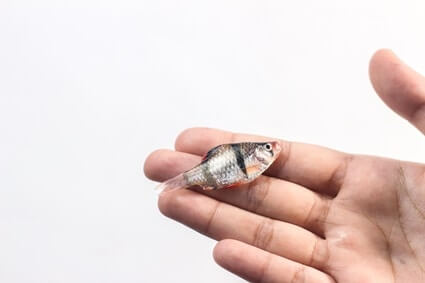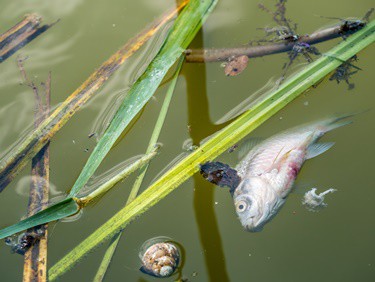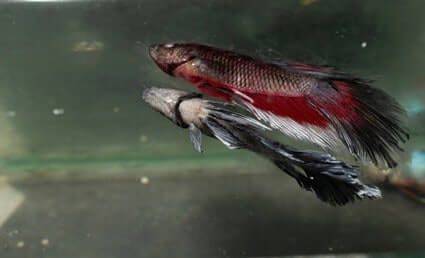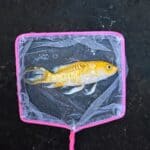When disposing of a dead pet fish, act swiftly to prevent the tank’s conditions from deteriorating. During disposal, wear gloves to protect yourself from harmful bacteria.
A popular disposal method is to bury the fish in the yard or a potted plant. As long as it’s not too hot, you could put it in a bin. Cremation and composting are also good disposal methods.
Don’t flush dead fish down the toilet because it could block drainpipes or give diseases to native species.
Before disposing of a deceased fish, put it in the freezer until ready to dispose of it. This will prevent the fish from decomposing, giving you the chance to decide on the right disposal method.
How To Check Whether A Fish Is Dead
Many fish appear dead, especially when sick, but they’re actually alive and have slowed their bodies down to conserve energy. Some dead fish are just extremely lethargic.
Similarly, fish pretend to be dead to evade predators. Depending on what community fish you have in the tank, smaller fish become prey for larger species, causing them to adopt protection techniques.
According to Behavioral Ecology and Sociobiology, some fish exhibit a death-feigning strategy called thanatosis to attack and subdue prey. Cichlids are known to adopt this strategy.
Before getting rid of a deceased fish, you must determine if it’s dead. To do this:
Check for Signs of Breathing
To check whether your fish is breathing, pay attention to the gills. If they’re not moving – even the tiniest bit – then the fish isn’t breathing.
However, bear in mind that some fish breathe through their mouths. If this applies to yours, look out for signs of shallow breathing, such as the body moving inwards and outwards or the mouth opening and closing. The fish is dead if the body and mouth remain completely still.
Observe The Eyes
If the eyes appear sunken, the fish is dead or dying. If you remove the fish from the water, the eyes won’t move and will stare motionless. Cloudy eyes also signify death.
The pupils will rotate downward if the fish is still alive.
Feel The Body
Dead fish will feel stiff and rigid because Rigor Mortis has set in.
For fish that jump out of the tank, examine the scales as you pick the fish up. Fish that have been out of the tank for a long time will feel dry and cracked because their bodies are dehydrated.
If it’s soft or floppy, it’s either still alive or has only recently died.

Check The Smell
Dead fish smell bad once the decomposition process sets in. If the fish has been dead for a long time, the odor will likely make you want to gag.
The fish must be removed from the tank immediately. That’s because dead fish emit high levels of ammonia, causing the ammonia in the tank to rise to dangerous levels.
Is It Floating or Sinking?
Dead fish will float to the surface or sink to the bottom of the tank. Post-death, smaller fish, like guppies and tetras, float. Larger fish, like cichlids, sink to the bottom.
Most owners see their fish floating at the surface once the gasses that have built up in the dead fish’s body cause it to rise. If you notice this in your tank, you likely have a dead fish.
What To Do With A Dead Fish
Now you know the fish is definitely dead, you must dispose of the body safely.
If you’re not quite ready to dispose of the fish and need time to find a suitable method, place the corpse in an airtight plastic bag or container and place it in the freezer.
Before disposing of the fish, remember to discard the plastic bag or container, as they won’t biodegrade and will stop your fish from decomposing.
Here are some of the best ways to dispose of a dead pet fish:
Backyard Burial
A backyard burial allows owners to keep their pets nearby, allowing them to visit occasionally.
Burying the fish in the soil is recommended because it’ll decompose naturally. To prevent animals from digging up the fish, you must put it at least 1 meter into the ground.
You can also bury a fish in a biodegradable fish casket, like Paw Pods. They biodegrade 3-5 years after being planted, becoming part of the soil.
To memorialize a pet, plant a tree or plant where your fish is buried.
Alternatively, create a mini headstone dedicated to the deceased fish. You can even place a chair or memorial bench where the fish is buried so you can sit nearby on a nice day.
Potted Plant Burial
A sustainable method that many owners feel comforted by is to bury their fish in a houseplant.
While some people might be put off by having a decomposing fish in the house, burying a fish in a potted plant creates new life, continuing the fish’s life cycle.
It also helps protect the fish from wildlife who may dig the body up in the backyard. This is common in urban areas where foxes and wild dogs live.
As long as the plant pot is deep enough and there’s enough soil to cover the fish, there’ll be no foul odor. Instead, the soil absorbs the fish’s nutrients, allowing the plant or flower to grow.
By choosing your favorite flower or plant, you’ll be reminded of any happy memories. Also, if you move to a new house, you can take the fish with you.
To carry out a potted plant burial:
- Wrap the fish in a biodegradable cloth or tissue.
- Find a medium-sized pot and fill it halfway with soil.
- Lay the fish on the soil. Add another inch of soil over it.
- Pot the chosen plant or flower.
Remember to water the plant regularly, just like you would other potted flora.
Put It In The Bin
Not everyone is comfortable with the idea of burying their fish in their backyard or potted plant. Instead, you could put the fish in a waste bin.
This isn’t a sentimental burying method, but it gets rid of the fish more safely than flushing. This isn’t the best idea on a hot, sticky day because the dead fish will begin to smell.
It also increases the chance of zoonotic diseases, putting you at risk when you put waste in the bin. This also risks the safety of sanitation workers who come into contact with the fish.
If you decide this disposal method is right for you, wrap the body in an airtight bag or place it in a cardboard box to reduce contact. This should also keep flies away and lessen the smell.
The final option is to leave your pet fish in the freezer until bin collection day.
Compost
Composting dead fish seems less callous than just throwing it away.
Compost is added to soil to help plants grow and is made from organic materials. As a result, the dead fish could provide essential nutrients that plants need to thrive.
The only issue with composting dead fish is that it creates odor problems and attracts flies and animals, according to the United States Environmental Protection Agency.
A small fish should be okay as long as it’s buried deep into the composting material. If you don’t have a composter, take the fish to a local composting center, which will do it for you.
Cremation
Cremation is a preferred disposal method for some fish owners. Burning kills all bacteria, parasites, and pathogens, making it one of the most hygienic ways to dispose of a fish.
This disposal method isn’t for everyone, so consider whether cremating the fish will amplify the grieving process for you. To cremate a fish at home, follow these steps:
- Preheat the oven to 200 degrees. Once hot, put the fish on a baking tray lined with baking parchment and a piece of aluminum foil.
- Keep the fish in the oven for 15 minutes or until it’s completely dry.
- Once the fish is dehydrated, leave it to cool for a few hours.
- Find a fire-proof pot and place the fish inside. Build a fire, monitoring it at all times.
- Once the fire and embers are hot, place the pot on the embers.
- After a while, the fish will turn to ash. Leave it to cool before removing it from the pot.
Once you have the ashes, you can place them in an urn or turn them into memorial jewelry.
Bear in mind that depending on where you live, cremation may be illegal. As a result, there are small pet cremation services that will cremate pet fish and return the ashes to you.
Pet Cemetery
Pet cemeteries allow owners to choose a plot, casket, and grave marker. After the fish is buried or cremated, you and your family can visit the plot whenever you like to pay your respects.
Can You Flush A Dead Fish Down A Toilet?
Flushing a dead fish down the toilet is one of the most common forms of disposal.
Unfortunately, the popular animated film Finding Nemo romanticized the false idea that all drains lead to the ocean, encouraging owners to flush their fish down the toilet.
However, it’s among the most irresponsible ways of getting rid of a dead fish for these reasons:
Disease Transmission
If a fish dies from a contagious disease or parasite, it could pass it on to native fish living in wild waters. This could harm local fish populations. Contagious health conditions include:
Similarly, it’s unsanitary to dispose of a dead fish in a bathroom.
Blocked Pipes
A fish can block the drain, and there’s little way of knowing what condition your drains are in. If they’re completely clear, you might not have a problem, but it’s an expensive risk to take.
It’s not uncommon for big fish or groups of dead fish to get stuck within the drainage system. Also, if the fish gets stuck without you realizing it, it’ll decompose and create a bad odor.
Toilets are only intended for toilet paper and human urine and feces.
Can You Feed A Dead Fish To Other Pets?
If you have pets that love the taste of fish, you might be tempted to feed the carcass to them instead of disposing of it. After all, why let meat go to waste? Unfortunately, this is a very bad idea.
It’s difficult to tell how long the fish has been dead, and the fish could have died from a disease. You could be exposing a cat, dog, or other domestic animals to harmful bacteria and pathogens.
Small bones could get stuck inside your pet’s throat. They could also perforate their stomach or intestines as the fish is digested, causing internal injuries.

Can I Get Sick from Handling A Dead Fish?
Be careful when handling a dead fish because it can transmit zoonotic diseases, making you unwell.
As described by Washington State University, most zoonotic diseases associated with fish are bacterial. Always wear gloves when handling dead fish, and wash your hands with antibacterial soap.
If you don’t, you’re at risk of getting the following health conditions:
Fish Handler’s Disease
Fish handler’s disease is also described in the following terms as it describes similar conditions:
- Fish handler’s disease.
- Fish handler’s nodules.
- Fish tank granuloma.
- Fish tuberculosis.
- Erysipeloid.
- Mycobacteriosis.
- Piscine tuberculosis.
- Swimming pool granuloma.
Fish handler’s disease gets into the skin through cuts and scrapes. It occurs after handling affected fish or touching infected water. Signs of fish handler’s disease include:
- Localized skin lesions, usually on the fingers and hands.
- Non-healing sores.
- Small red bumps.
- Fever.
- Enlarged Lymph nodes.
The best way to prevent the infection is to wear gloves when removing the dead fish.
Streptococcus Iniae
As described by the Journal of Clinical Microbiology, Streptococcus iniae is a bacterial pathogen carried by fish. It’s similar to fish handler’s disease but has different origins. It can infect humans, causing:
- Cellulitis.
- Arthritis.
- Endocarditis.
- Meningitis.
- Death.
Most people become infected by a puncture wound while handling infected dead fish.
Anyone who develops the infection must avoid contact with live fish or aquarium water to prevent the condition from worsening. Streptococcus iniae causes:
- Local skin infections.
- Sepsis.
- Toxic shock syndrome.
- Inflammation of the skin.
The infection can be treated with a course of antibiotics.
Don’t give in to the temptation of flushing it down the toilet. There are other fish disposal methods you can use to give a fish a good send-off without risking native wildlife or damaging the drains.







